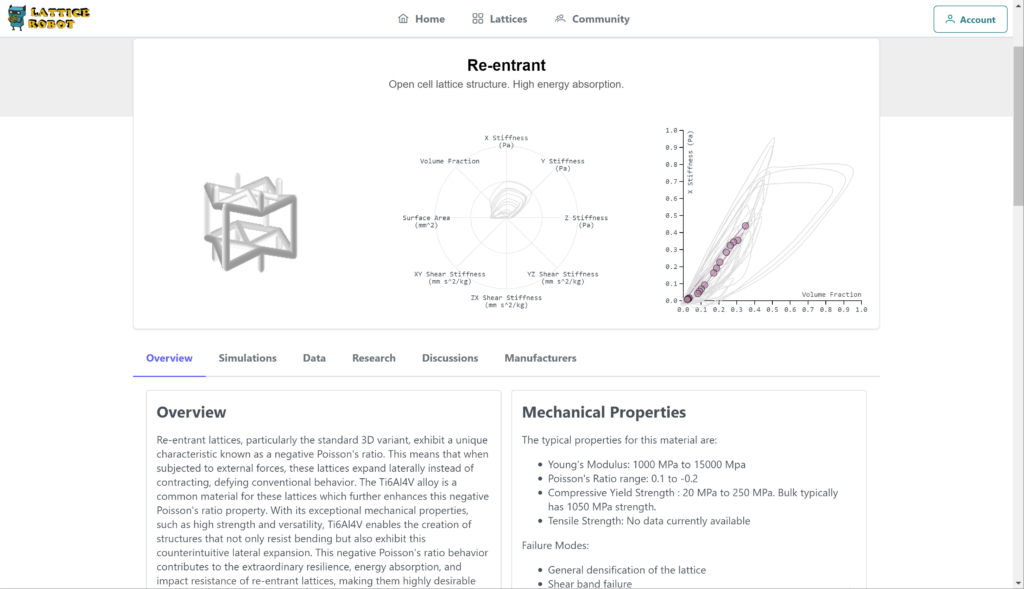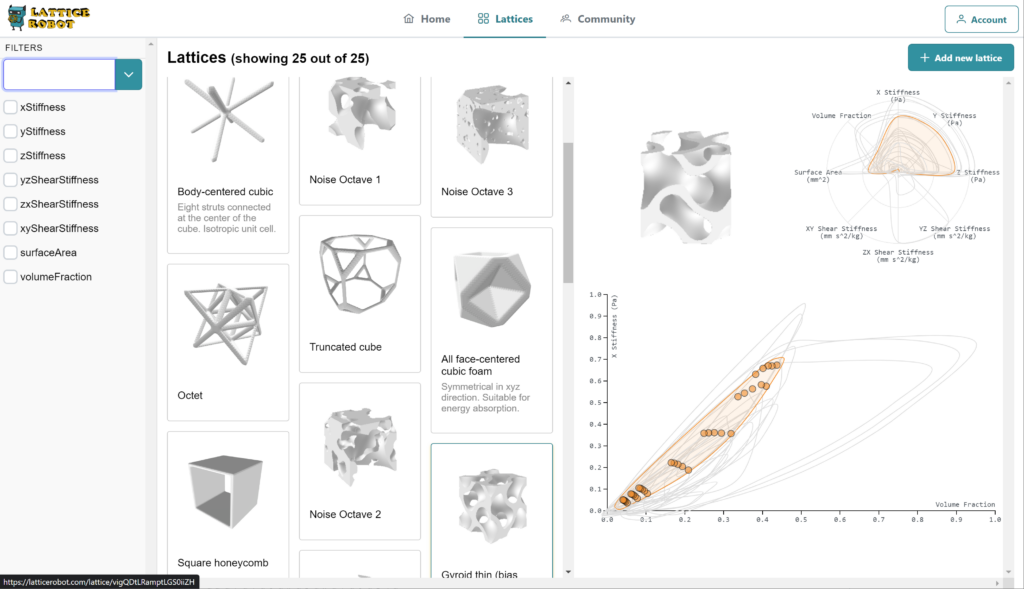At the CDFAM computational design (+DfAM) symposium this week, a startup dedicated to lattice software, LatticeRobot, was launched. LatticeRobot is also the first Gradient Control Labs, an incubator that facilitates the market entry for software firms. LatticeRobot wants to be a nexus for lattice information, exchange, education, and use. LatticeRobot CEO Matt Shomper described the evolution of the company this way:
“I’ve spent the past decade delivering innovation through novel lattices and foams in metal additive manufacturing, an expensive and time consuming process. The way we ultimately accelerate progress is by combining our knowledge and working together, and that’s why we built LatticeRobot.”
Relying on empirical, functional data, LatticeRobot features an interactive environment so that engineers can explore combinations of base materials and lattice geometries to achieve data-driven and optimized implicit unit cells. These cells then work with modern latticing software. Moreover, data from hardware, software, and consulting vendors guides users to referenced products and services, helping users discover the best fit products and services for their applications.
“LatticeRobot is a great approach that bundles decades of hard-to-obtain knowledge of the leading experts in design for additive manufacturing and makes advanced lattice engineering accessible to everyone,” said Autodesk´s Director of Additive Manufacturing, Alexander Oster.
LatticeRobot is the first startup in Gradient Control Labs’ portfolio. Gradient in and of itself is very innovative and could make software firms much more competitive, while speeding up their market entries. Gradient Founder Blake Coulter explained the vision behind the incubator:
¨Engineering software startups usually suffer from at least one of these pathologies: The team built the last generation of tech, and is just trying to make a better platform, but without enough focus on new markets or applications. The team has found the hardest, most interesting problem to solve, but it’s a niche in a niche in a niche. The CEO and team have a beautiful vision to solve a new market problem, but they can’t recruit a technical team with enough expertise. I’ve gotten together with some engineering software folks to create a new incubator, Gradient Control Labs, that addresses these issues by building a world-class product for new companies, so the management team can be completely focused on market need. We institute best practices so the management team can focus on product priorities and worry less about delivery.¨
LatticeRobot is currently private beta and will be released publicly in the fall of 2023. I’m a noted lattice skeptic, with the belief that these design elements are the answer to every problem. Their behavior and performance have been difficult to predict and they have issues with performance under repeated and shear stress. Lattices in open structures are problematic in a number of applications.
I also believe that ´lattice thinking´ is kind of a closed system, if you believe that lattices are the solution by default, then you’ll see and use them everywhere without considering other geometries. Additionally, I’m hesitant to promote hip geometry generally because people may be inclined to show off specific geometric designs meant to illustrate their own sophistication, rather the best solution. I’m not like a lattice hater, though—just a skeptic. They can be very useful in a lot of applications.
Despite little old me, LatticeRobot seems like a smart play. Lattices are experiencing a hype-filled moment and some see them as the solution to everything. The community also hopes to deal with metamaterials, another area of much excitement and discussion, and textures. In 2021, I wrote about how proprietary textures could very well become in-demand products.
However, metamaterials, textures, and lattices are poorly understood and people often are not able to get them to perform to spec or do not sufficiently understand their performance. A place that would be a trading ground for these pieces of valuable geometry as well as somewhere where you can learn about such things could be very valuable. This is exactly the goal of LatticeRobot. If we assume that there is one geometry that’s the best texture for a rain jacket and another that’s best for a golf ball, then it’s easy to see the considerable monetization potential, direct or indirect.
I myself am very excited about proprietary, unique, mass-customized and functional textures. Imagine an optimal texture for wicking sweat in a TPU part printed on a textile. That seems like a bit of a long shot and niche area now, but, as our market evolves, TPU soles, shoes, handles and other gear will make such a texture very valuable eventually. And the key element here is that somewhere there is a misunderstood, unknown shape that delivers superior performance over other shapes. If LatticeRobot can teach people how to make these geometries and help others find them, then a big business opportunity might accrue to them.
Subscribe to Our Email Newsletter
Stay up-to-date on all the latest news from the 3D printing industry and receive information and offers from third party vendors.
You May Also Like
Further Understanding of 3D Printing Design at ADDITIV Design World
ADDITIV is back once again! This time, the virtual platform for additive manufacturing will be holding the first-ever edition of ADDITIV Design World on May 23rd from 9:00 AM –...
3D Printer Maker EVO-tech Reborn as NEVO3D — Once More With Feeling
EVO-tech was a 3D printing service and original equipment manufacturer established in 2013 and based in Schörfling am Attersee, Austria. The company produced high-quality material extrusion systems featuring linear bearings,...
3D Systems Brings 3D Printed PEEK Cranial Implant to the U.S. with FDA Clearance
For more than 10 years, 3D Systems (NYSE:DDD) has worked hand-in-hand with surgeons to plan over 150,000 patient-specific cases, and develop more than two million instruments and implants from its...
CDFAM Returns to Berlin for Second Annual Symposium
The second CDFAM Computational Design Symposium is scheduled for May 7-8, 2024, in Berlin, and will convene leading experts in computational design across all scales. Building upon the first event...

































